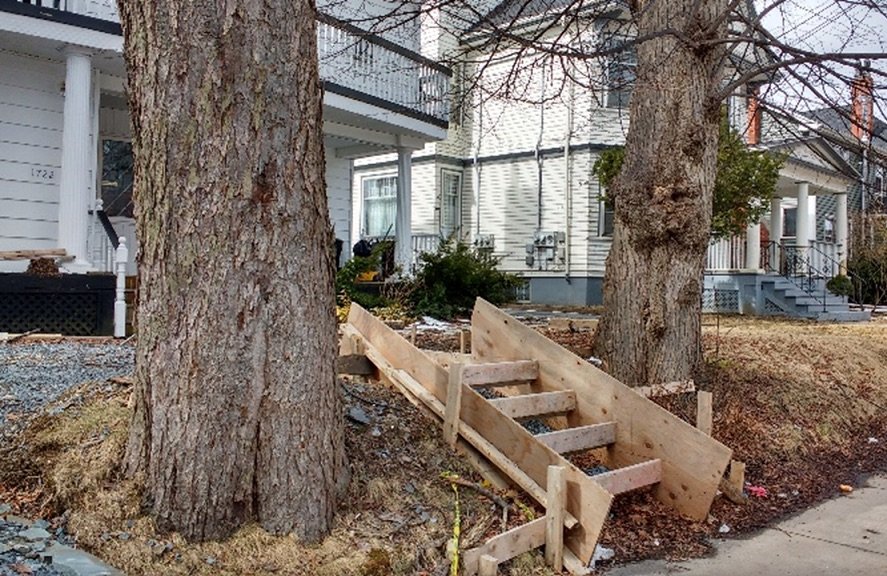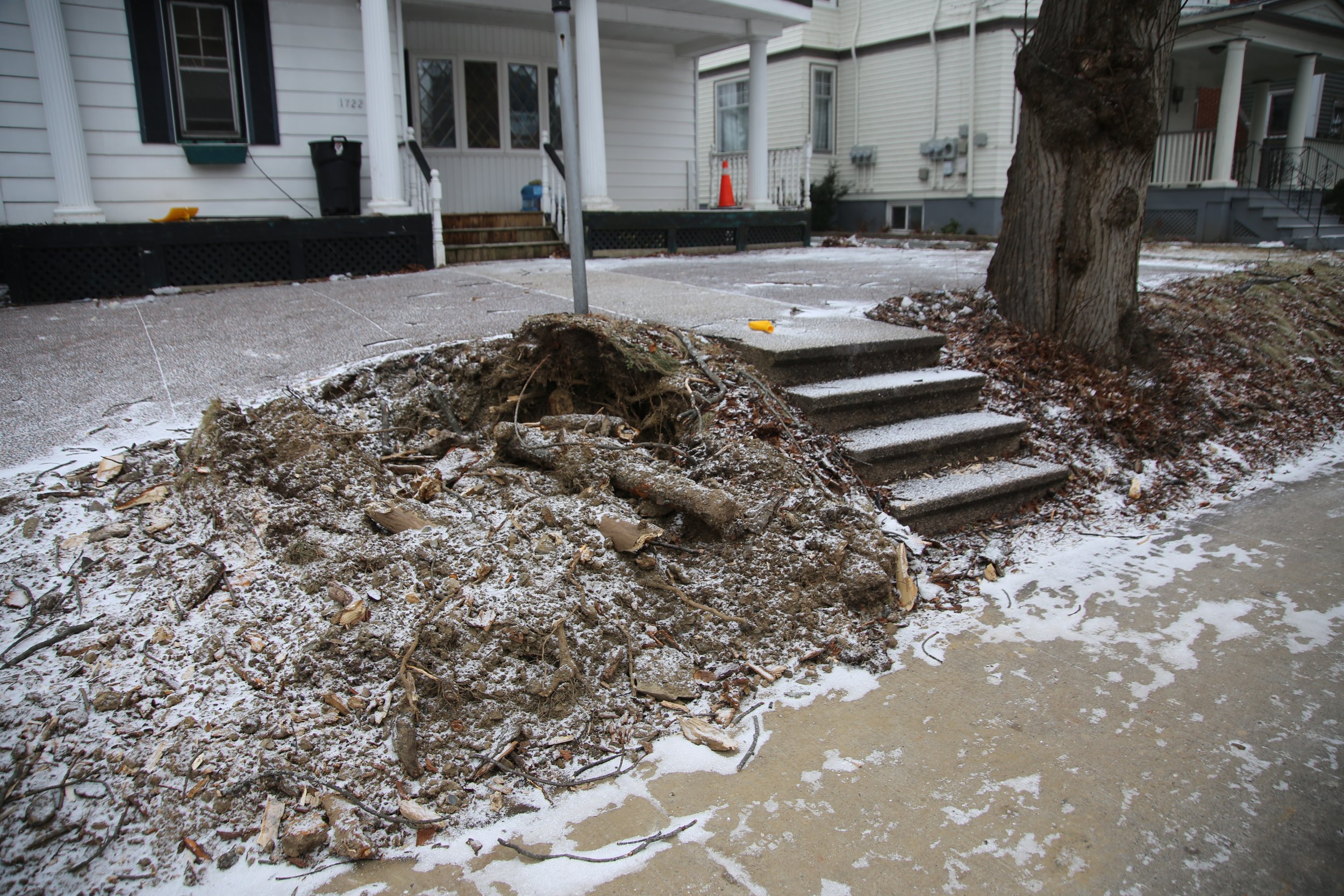Building Renovations as a Cause of Tree Mortality
James Steenberg, Halifax Tree Project
2022-01-09
Back in 2014, I set out into the streets to try and figure out what kills trees in the city. It was the field research component of my PhD and it came about in a fortuitous way - a citizen science group had conducted a tree inventory of their neighbourhood eight years prior. This afforded me the opportunity to go back and re-measure the same trees and, among other things, conduct a full post-mortem on all the ones that gave up the ghost during those eight years.
Before getting into what I found, let’s take a step back at the meaning and utility of such a research endeavour. That is, trying to identify and assess the causes of urban tree mortality. The urban environment can be a stressful one for trees, especially the street environment, and trees often die much earlier than one might expect according to their silvics and biological lifespan. When I started my research on this topic, my headspace was: ‘trees die way more in the city than in the forest, and that’s bad - let’s figure out why’.
In actuality, a tree growing in the forest is orders of magnitude more likely to die than a tree in the city. In Nova Scotia, for example, a naturally regenerating forest might have tens of thousands of seedlings and saplings per hectare. Tens of thousands of these trees will subsequently be killed by competition as the forest matures – a process called stem exclusion – to between a few hundred and maybe a thousand trees per hectare. So comparatively, it’s not the actual number of trees dying in the city or the likelihood of mortality that’s at issue.
I eventually shifted my headspace to: ‘trees die in the city when we don’t want them to – let’s figure out why’. We derive a much greater array of benefits from an urban tree compared to a tree in the woods (in part because there are fewer of them) and we typically invest orders of magnitude more resources into an urban tree compared to a woodland tree. In ecological terms, we take a ‘K-strategist’ approach to the urban forest as opposed to an ‘r-strategist’ approach. An r-selected species takes the approach of producing oodles of offspring, leaving them to their own devices as a small number survive (e.g., salmon), while a K-selected species invests high amounts of resources in raising a small number of offspring (e.g., whales). While these terms are more often used in describing animals, not plants, trees certainly are more like the former and not the latter. I believe managing them as K-strategists as we do (and as we often must) in the city is at the heart of our troubled relationship with urban tree mortality.
All this to say, I really wanted to uncover some insights in my field research on the correlates (and hopefully causes) of tree mortality. However, the approach I took to the research was definitely an r-strategist one – and arguably a little lacking in design. I tried to measure a little bit of everything that could be measured and then throw it all against the wall of statistical analysis to see what might stick. Sidewalk width and a tree’s distance to the street, planting environment and impervious cover around the tree, signs of either tree vandalism or stewardship – you name it, I tried to measure it.
I remember the dark winter’s evening when I finally finished all the data cleaning, processing, and statistical analysis and seeing what any data-fearing young researcher fears: p = 0.27. In other words, my analysis was not statistically significant. Of all those things I measured, nothing appeared to be contributing to urban tree mortality in a meaningful way. Was it all just a game of chance and un-generalizable events?
My co-authors and I ended up diving deeper into the data and did find a few interesting nuggets using machine learning techniques(1). However, the real insight came from some casual observations in the field around one of the few things I didn’t measure while collecting data. The one relatively consistent pattern we noticed was that where there should have been a mature tree standing (according to the first tree inventory), there was now a new driveway, front porch, or home addition.
Photo 1a. Infrastructure installation beside Robie St. in Halifax. A new staircase plus driveway paving. Photo by James Steenberg, date unknown.
Were home renovations the undiagnosed killer of my urban trees? If so, how can these be measured short of knocking on every door and asking people if they recently had some work done? We decided to pursue these questions through an unlikely source of municipal administrative data that are increasingly available to the public through open data initiatives: building permits.
The City of Toronto – where this research took place – had 15 years of building permit data available through their open data portal. Hundreds of building permits had been issued in my study area during those eight years between tree measurements. Sure enough, the analysis found that trees were more likely to die on properties that had a building permit and tree mortality rates increased in areas (e.g., city blocks) as the number of permits increased(2).
Photo 1b. Tree failure on account, at least partly, of infrastructure installation. The missing tree is the one on the left of Photo 1a. Photo by Peter Duinker, January 2022.
We expanded this research to look at the entire city using canopy cover data, permit data, census data, and air photos to confirm where individual trees had actually died over a ten-year period(3). The pattern held true – it turns out that outdoor renovations at your home or business is a consistent cause of urban tree death, whether it’s deliberate tree removal or accidental damage to the tree, above or below the ground.
The take-away message of this personal journey (and accompanying rant) is two-fold. First, whether you are an urban forest researcher, citizen scientist, or workaday tree enthusiast or steward, keep your eyes peeled and mind open when assessing your trees (and check out unexpected and novel data sources!). Second, while big shocks like hurricanes or a new invasive insects kill swaths of urban trees and are a major threat, I believe that it is unintentional damage to trees during small renovation projects, especially their root systems, that is a chronic cause of unwanted tree mortality in the city. Tree Protection Zones are one possible option for mitigation used in other cities(4), but really the first critical step is education and awareness.
Photo 2. A building contractor makes a promise on a Halifax building lot and then breaks it, in plain view.
(1) Steenberg, J. W., Millward, A. A., Nowak, D. J., Robinson, P. J., & Smith, S. M. (2019). A social-ecological analysis of urban tree vulnerability for publicly-owned trees in a residential neighborhood. Arboriculture & Urban Forestry. 45, 9-23.
(2) Steenberg, J. W. N., Robinson, P. J., & Millward, A. A. (2018). The influence of building renovation and rental housing on urban trees. Journal of Environmental Planning and Management, 61, 553-567.
(3) Steenberg, J. W. N., Robinson, P. J., & Duinker, P. N. (2019). A spatio-temporal analysis of the relationship between housing renovation, socioeconomic status, and urban forest ecosystems. Environment and Planning B: Urban Analytics and City Science, 46, 1115-1131.
(4) City of Toronto. (2022). Permits & Tree Protection – Tree Protection Zones. Retrieved from https://www.toronto.ca/services-payments/building-construction/tree-ravine-protection-permits/tree-protection/


